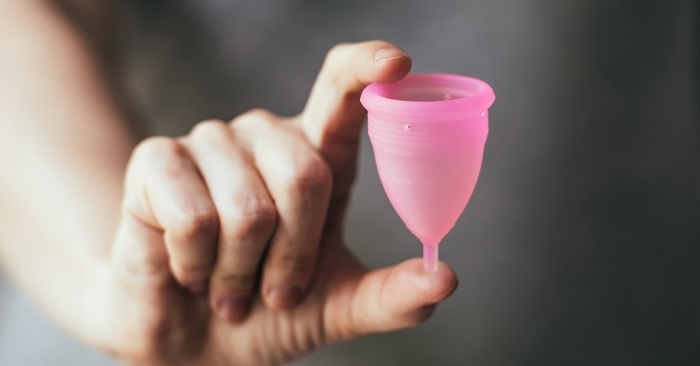There are many menstrual products on the market for people to choose from when dealing with their periods. One product that has been around for quite some time but has become more popular in recent years is the menstrual cup.
The menstrual cup is a device that is inserted into the vagina to collect blood and prevent it from leaking out during a menstrual period. When the cup is full, it can be removed and emptied into a toilet before being cleansed and reinserted.
Menstrual cups are usually made out of silicone, with some being made of rubber. People with latex allergies should choose silicone versions.
When deciding whether or not this product is right for you, take a look at this list of menstrual cup pros and cons.
Pros of the Menstrual Cup
- Eco and Budget-Friendly: Switching to the cup will reduce the amount of garbage you produce during your menstrual period because you will not be throwing out pads and tampons. Reducing landfill waste is definitely good for the planet, making the menstrual cup an eco-friendly choice. Also, because you do not need to replace the menstrual cup each month, it is cost-effective as well. If you take care of them properly, some cups can be used for years. A menstrual cup may be a slightly larger investment at first, especially higher quality versions. However, any extra expense is more than made up for after a few cycles. There are also less expensive reusable menstrual cups available that are comparable in price to a box of tampons.
- Less Shopping for Menstrual Products: If you’re using disposable menstrual products like tampons or pads, you have to keep buying them for each period. Not only is this more expensive than using a menstrual cup, but multiple trips to the drug store can also be an inconvenience. As long as you maintain your menstrual cup properly, you will always have it on hand without needing to go to the store for supplies. Just keep track of when your period is due and have it ready to go before that date to be prepared. If you are concerned about starting your period when you’re away from home, a case can be used to keep it in a purse or book bag around the time you expect it to start.
- Helps with Maintaining Healthy Vaginal pH: Tampons are used to absorb blood, but they also absorb any other vaginal fluid present. This may lead to a disturbance in your vaginal pH or the healthy bacteria that should be there. The menstrual cup does not absorb anything, so this problem is avoided.
- Less Odor: If you’ve used tampons or pads before, you may have noticed they can develop an odor as they absorb more blood. The odor becomes more noticeable when it is exposed to air, which is especially a problem with menstrual pads. With the cup, the blood is contained by a non-porous barrier, so it is not exposed to air. Therefore, odor is less common when using a menstrual cup.
- Longer Wearability: In addition to the general longevity of a menstrual cup, you can also usually go longer between trips to the bathroom to deal with your period. The menstrual cup is often able to hold more blood than a pad or tampon can absorb, which means it needs to be emptied less often than other products need to be changed.
Also, menstrual cups are made of body-safe materials that do not contain the chemicals some single-use products do. The risk of a rare condition known as toxic shock syndrome (TSS) that is associated with tampon usage is eliminated when using a menstrual cup.
Cons of the Menstrual Cup
- Learning to Properly Insert It Takes Practice: The most common complaint about the menstrual cup is that it is difficult to insert at first. Because there is a learning curve, some women get frustrated and give up after several attempts. This is especially true for young women who have just started their menstrual cycles and women who have not had intercourse. However, with practice, most women can get the hang of proper insertion. It should be noted that individuals with IUDs may want to consult their doctor about using the menstrual cup because it may pull on the IUD’s strings and dislodge it.
- Fit Issues: The menstrual cup comes in a variety of sizes, with guidelines and recommendations for what size may be appropriate for certain women. However, if you have a condition like a dropped uterus or severe fibroids, fit may be an issue.
- More Mess: A couple of menstrual cup pros and cons are related to the way it collects blood rather than absorbing it. This is a pro for reusability and length of time between changes. However, for some women, dealing with the menstrual blood is a turn-off. If you’re used to simply throwing away menstrual pads and tampons, it may take some getting used to the menstrual cup. With practice, many women will master removal with minimal mess.
Another con related to mess is the need to rinse or clean the cup before reinsertion. Some feel uncomfortable doing this in the sink, especially in public restrooms. To deal with this, some women carry a small squirt or spray bottle of water while using the cup, or bring wipes.
- Issues with Cup Removal: Removing the menstrual cup can have as much of a learning curve as inserting. And removing it improperly can cause a lot more mess than inserting it incorrectly. While each cup as a “stem” at the bottom, it is not the best idea to use it on its own for removal. The cup should be squeezed just above the stem and pulled out.
- Proper Maintenance: Because the menstrual cup is reusable, it must be taken care of properly. If you neglect proper maintenance of your cup, it can introduce bacteria or other germs into the vagina the next time you use it. Or if it is not taken care of properly, it will not last as long as it should. After each cycle, you should sanitize it by using boiling water or a cleanser made for the material, like solutions used for baby bottle nipples.
Have More Questions?
Raleigh OB/GYN Centre has been caring for women in all stages of life for over 40 years. From the first gynecological exam through managing menopause, our expert physicians will be there. To speak to one of our doctors about any gynecological issue, including the best options for menstrual products, you can call us at 919-876-8225. You can also request an appointment online.


